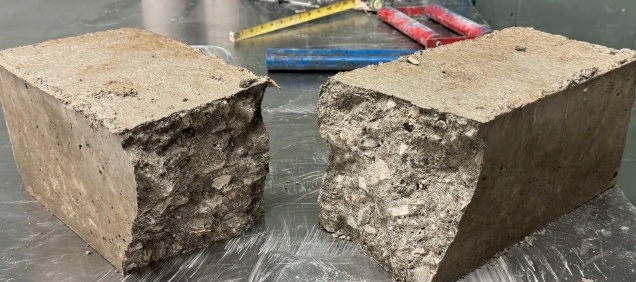Recycled Plastics Incorporated into Road Construction: US Research Institution Solves Material Challenges
As the demand for materials in road construction continues to grow, the supply of plastic waste is also increasing simultaneously. Integrating recycled plastics into the aggregates of transportation infrastructure is becoming a research direction of great interest. Recently, tests on recycled plastics in asphalt and concrete pavement mixtures have achieved encouraging results, while also highlighting the need to explore their long-term performance and durability.
Recycled Plastics: The Key to Solving Road Material Shortages and Pollution Problems
Currently, the supply of high-quality aggregates to meet the demands of local road and highway construction is often insufficient, while plastic waste continues to accumulate in large quantities. In the United States, plastics are one of the main sources of waste, but the recycling rate is less than 10%. Converting plastic waste into road materials is expected not only to bring significant environmental benefits but also to generate considerable economic value.
However, there are still many questions regarding the feasibility and material performance of recycled plastic-enhanced pavement mixtures. The Minnesota Department of Transportation (MnDOT) and local agencies are eager to understand whether upgrading (i.e., using waste plastic to create higher value products) for road construction can meet specifications and performance requirements, while also contributing to sustainability goals and addressing the accumulation of plastic waste.

Research Method: Comprehensive Exploration of the Application Potential of Recycled Plastics
The research team first conducted a comprehensive review of existing practices, pilot projects, and other studies on incorporating recycled plastics into asphalt and concrete road paving, thoroughly exploring the performance and durability of proprietary and non-proprietary products such as binders, additives, fiber reinforcements, and sealants.
Subsequently, through an online survey of more than 30 recycling facilities and various recycled plastic material suppliers (including suppliers that produce fibers from wind turbine blades), the researchers identified and characterized the plastic waste materials to be tested. In-depth interviews with some respondents further revealed product characteristics, disposal methods, the recycling capabilities of different types of plastics, and the challenges faced in handling plastic waste.
“This research is highly insightful for understanding the advantages and disadvantages of incorporating plastic components into asphalt and concrete pavements. Gaining an understanding of the long-term performance of plastic fibers in concrete will support the feasibility of sustainable road options,” commented Jim Johnson, Public Works Administrator of Chisum City.
In the laboratory, researchers evaluated the effects of adding plastic waste to asphalt and concrete mixtures. The asphalt tests involved incorporating granular recycled plastic from two different sources into a typical MnDOT binder to determine suitable mixing times, performance grades, and separation tendencies. Finally, tests were conducted on both plastic-enhanced binder asphalt mixtures and non-enhanced mixtures for temperature cracking resistance and moisture sensitivity.
Researchers evaluated concrete mixtures using a native plastic and three recycled plastic materials (including fibers and sand) as aggregate replacements. The tested fresh and hardened properties included workability, air content, compressive and flexural strength, and durability.
Research Findings: Recycled Plastics Show Both Potential and Challenges
Plastic suppliers involved in the project have noted the growing trend of upgrading and recycling plastic materials for use in transportation infrastructure. However, they emphasize the need to investigate the long-term performance and durability of pavements constructed with these materials. Companies face challenges such as contamination of materials by food and liquids, high processing costs, complex plastic recycling and reprocessing technologies, and limited markets to support production.
The study found that the optimal mixing time to upcycle waste plastic into asphalt binders is 15 minutes. Since some plastics will separate from the modified binder, researchers concluded that the binder should be used immediately after mixing rather than stored. The amount of plastic material added to the binder is 1.5% of the weight of the virgin binder, which results in a reduction in the mixture's crack resistance.
Incorporating waste plastic into concrete mixtures reduced workability by approximately 50%. Plastic fibers increased the compressive and flexural strength of the mixtures compared to the control mixtures, while plastic sand-modified mixtures exhibited lower compressive strength. Waste plastic materials enhanced the durability of the concrete mixtures. These materials replaced 20% of the aggregates, which is significantly higher than the amount of waste materials used in asphalt mixtures.
Future Prospects: Recycled Plastic Road Materials Have Broad Potential but Require In-Depth Research
Upgraded and recycled plastic-modified concrete mixtures show great potential to achieve or even surpass the performance of traditional mixtures, and may bring significant environmental benefits. However, further research and field testing are still required. Potential research issues include the variability of plastic quality and processing techniques, asphalt separation problems, and long-term performance.
Research in Minnesota and other states will advance knowledge, bringing local agencies and MnDOT closer to the goal of incorporating waste plastic into sustainable roads.
【Copyright and Disclaimer】The above information is collected and organized by PlastMatch. The copyright belongs to the original author. This article is reprinted for the purpose of providing more information, and it does not imply that PlastMatch endorses the views expressed in the article or guarantees its accuracy. If there are any errors in the source attribution or if your legitimate rights have been infringed, please contact us, and we will promptly correct or remove the content. If other media, websites, or individuals use the aforementioned content, they must clearly indicate the original source and origin of the work and assume legal responsibility on their own.
Most Popular
-

At Least 44 Dead in Century-Old Fire! Questioning Hong Kong's Hong Fu Garden: Why Has the Path to Fire Resistance Taken 15 Years Without Progress?
-

Satellite chemical's profits surge! can the 26.6 billion yuan high-end new materials project meet expectations? a review of progress on four major projects
-

Key Players: The 10 Most Critical Publicly Listed Companies in Solid-State Battery Raw Materials
-

Estun Turns Profitable in 2025 Half-Year Report, Industrial Robot Shipments Rank First Among Domestic Brands
-

Avatr Files for IPO on HKEX, Plans to Complete Listing in Q2 2026






